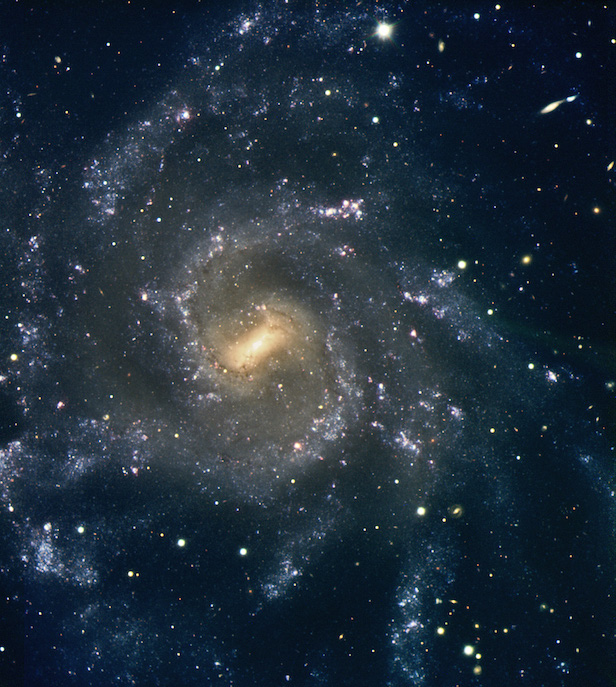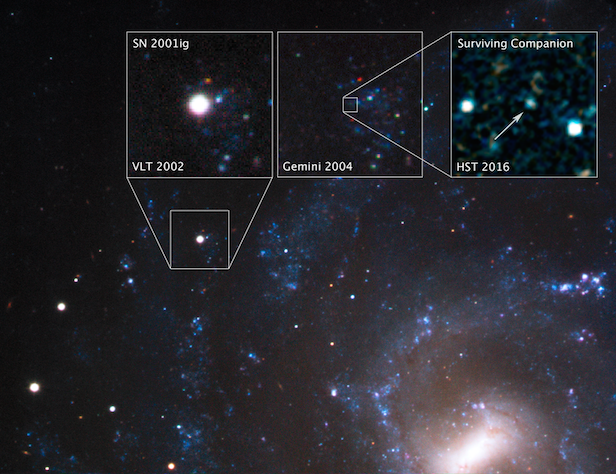Hubble spots a supernova’s surviving companion
17 years after the initial supernova, astronomers have photographed its companion star for the first time ever

NGC 7424 is located 40 million years away in the southern constellation of Grus, the Crane. Image credit: ESO
NASA and ESA’s Hubble Space Telescope has found and imaged a surviving companion to a supernova, the first image of its kind. 17 years ago and 40 million light years away in a galaxy called NGC 7424, a enormous stellar explosion occurred in the form of a supernova, and now astronomers have visually seen its companion star. This is the first evidence to the theory that some supernovae originate from a binary double-star system.
“We know that the majority of massive stars are in binary pairs,” says Stuart Ryder from the Australian Astronomical Observatory (AAO) in Sydney, Australia. “Many of these binary pairs will interact and transfer gas from one star to the other when their orbits bring them close together.”
This companion star was not just an innocent bystander, but instead installed much mischief. As the supernova’s protagonist star reached the latter stages of its life, the companion star stole hydrogen from the doomed star’s stellar envelope, the region that transports energy from the star’s core to its atmosphere. Millions of years prior to the supernova, a severe state of instability occurred when the hydrogen was stolen from the protagonist star. This caused shells of hydrogen gas to be expelled episodically.
This supernova, dubbed SN 2001ig, has been categorised as a Type IIb stripped-envelope supernova. This type of supernova is not usually seen, as most supernovae have hydrogen prior to the explosion. Alex Filippenko of the University of California, Berkley, discovered this type of supernova in 1987.
Although astronomers are certain that these supernovae occur with no hydrogen prior to the explosion, how this loss occurs in the first place is very uncertain. It was originally thought that single stars with very fast stellar winds ship off the outer envelopes. The issue with this is that astronomers couldn’t find primary star remnants for many stripped-envelope supernovae.
“That was especially bizarre, because astronomers expected that they would be the most massive and the brightest progenitor stars,” explains Ori Fox of the Space Telescope Science Institute in Baltimore. “Also, the sheer number of stripped-envelope supernovae is greater than predicted.” That fact led scientists to believe that many of the primary stars were in lower-mass binary systems, and this became the subject for many studies.

Hubble produced the first image of a supernova companion to a Type IIb supernova explosion. Image credit: NASA/ESA/S. Ryder (AAO)/ O. Fox (STScI)
The search for a companion star in a binary system proves to be no easy task, as there are many aspects to take into account when trying to find one. First of all, the stellar pair have to be relatively close to Earth in order for Hubble to resolve them. SN 2001ig and its companion were within the parameter, but that is not the case for other supernovae. Also, astronomers have to know the exact location through precise measurements.
The year after SN 2001ig’s explosion, astronomers were able to pinpoint the event’s precise location with the European Southern Observatory’s Very Large Telescope (VLT) in Cerro Paranal, Chile. In 2004, the Gemini South Observatory in Cerro Pachón, Chile conducted follow-up observations. These follow-up observations offered an initial indication that there was a surviving companion lurking in the vicinity.
Astronomers later zoomed in on the location using Hubble 12 years later, observing the after-effects of the supernova. Hubble’s exceptional resolution and ultraviolet capabilities created incredibly clear images of the surviving companion. This is something that only Hubble is able to do.
Scientists have since discovered that before the explosion the two stars completed one orbit roughly every year. When the primary star exploded, the shower of gas that was expelled into the cosmos seems to have caused less damage to the surviving companion than first thought. For example, imagine the dense core of the companion star is an avocado pit and its stellar gaseous envelope is a gelatin dessert. As a shockwave passes through, the gelatin might temporarily stretch and wobble, but the core will stay very much intact.
In 2014, Fox and his team used Hubble to gather spectral data – not an image – of a companion star to the Type IIb supernova SN 1993J. In the case of SN 2001ig, this is the first time a photograph has been taken of a surviving companion. “We were finally able to catch the stellar thief, confirming our suspicions that one had to be there,” says Filippenko.
It appears that as many as half of all stripped-envelope supernovae have companions, whereas the other half lose their outer envelopes via stellar winds. Ryder and his team now have the goal to precisely calculate how many supernovae with stripped envelopes have companions.
The next aim is to observe completely stripped-envelope supernovae, as opposed to supernovae such as SN 2001ig and SN 1993J, which are roughly 90 per cent stripped. These completely stripped stars don’t have much shock interaction with surrounding gas in the circumstellar environment, since their gaseous envelopes were lost a long time ago. Without a shock interaction the glow fades much quicker, meaning the team only have to wait two to three years before the surviving companion can be revealed.
Keep up to date with the latest news in All About Space – available every month for just £4.99. Get 5 issues of All About Space for just £5 with our latest offer!





